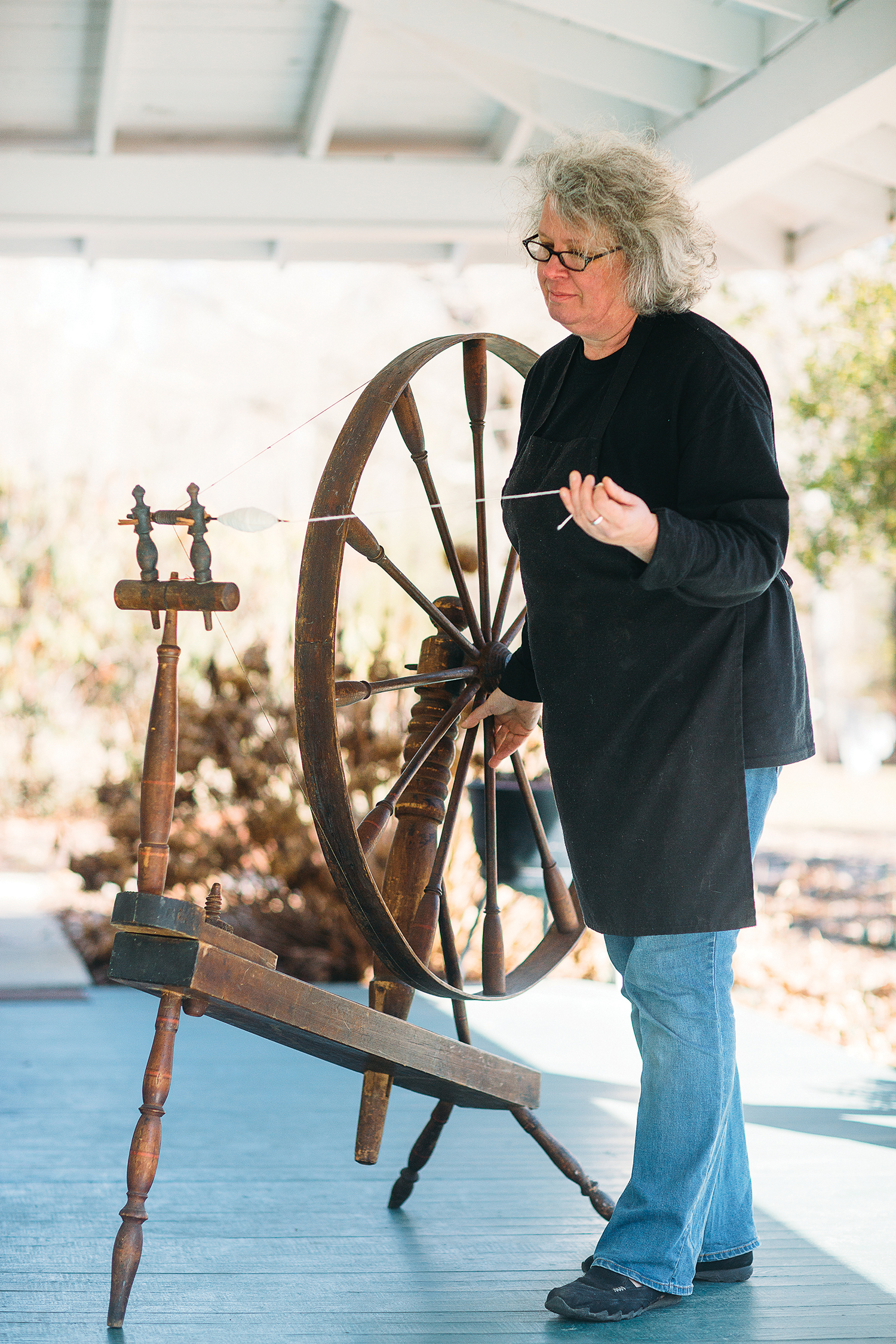
Vernon, left, and Leander Johnson with a team of draft horses. When they willed their family farm to the Henderson County school system, they started an important heritage-education center. (Photos used courtesy of Historic Johnson Farm)
Historic Johnson Farm in Henderson County celebrates its 25th spring festival this month — a stout anniversary in a region littered by come-and-go festivals. And yet, other tradition-heavy events in Western North Carolina have long surpassed that mark: the Asheville-based revels Shindig on the Green and Mountain Dance and Folk Festival, for example, will turn 49 and 88 this year, respectively.
What distinguishes the Johnson Farm festival, and in fact the whole estate — a heritage-education center with 10 historic buildings on 15 acres — is the progressive, almost preternatural vision of its founding brothers, Leander and Vernon Johnson. They embraced the seismic changes of the early 20th century, and what’s more, were seemingly ahead of their time in their quest to acquaint tourists and city-dwelling schoolchildren with country life: what we now call “agritourism.”
“They didn’t fear innovation, especially in the area of new technology,” acknowledges Farm Director Joy Owens. “According to oral accounts, they had one of the first in-home radios in Hendersonville. It cost more than their Model-T [Ford], but they considered it some of the best money they ever spent.” Bringing music, news, “and, most importantly, baseball games” into their home was definitely worth the price.
The understatedly handsome estate, a brick farmhouse approached through a lush wall of rhododendron, was built in 1880. With their mother, Sallie Johnson, Leander and Vernon ran it as a summer-retreat boarding house during the early and mid 1900s. Today, the farm is on the National Register of Historic Places and is designated a North Carolina Cultural Treasure. It is also owned by Henderson County Public Schools — one of only three farms in America owned by a school system.
The link makes sense, because after their mother’s death in 1958, the brothers, who had no natural heirs, turned full-bore to educational pursuits — from hands-on instruction for visitors to landscaping West Henderson High School when it was built adjacent to their property. They willed their farm and belongings to the local school system, including a plot of land to Rugby Middle School.
“In a way, they adopted the schoolchildren of Henderson County as their own,” says Owens. “They deeply cared about the education system, and saw their farm as a way to contribute to this. As life-long farmers, it’s easy to understand why they thought agricultural knowledge was valuable.”
The brothers also held degrees in engineering, however: chemical for Vernon and mechanical for Leander. When they coveted the fresh wonder of electricity — for the better comfort of their boarders, as well as for personal pursuits — the brothers installed their own power lines.
Perhaps most interesting, though, was their long-range views of farming practices. “This seems to be the one area they didn’t embrace technology,” notes Owens. “The boys, especially Leander, always lived very close to the land. They were wary of the potential environmental effects of new agricultural technologies. Leander even writes in one of his letters that he is concerned about the long-term effects of ‘all the spraying’ that was taking hold in modern farming methods.
“He was especially concerned with the effects on birds and insects, and what that meant for our own human health.”
Leander enjoyed a “unique bond with nature,” confirms family friend Becky Varnadore. “One summer day, he was sitting on a bench. He loved observing the beauty around him. Suddenly, a little bird flew down and perched right on his knee. He trained the little chipmunks to eat out of his hand.” She also notes that he was a “progressive thinker … very interested in alternative sources of energy, particularly solar.”
Varnadore and her husband Tony, who knew Leander through Tony’s ties to Rugby Middle School, lived in the brick farmhouse for 10 years, 1978 to 1988, and became very close to the younger Johnson brother, who was grieving hard after Vernon’s death.
“We had a brand-new baby, and Leander’s thought was that if we were there, we would bring some life to a place that had become lonely for him after losing his brother,” says Varnadore. “He was extremely independent and healthy, and made it clear we would not be taking care of him in any way.”
Becky also describes Leander as “humble, giving, intelligent, shy, generous, and honorable. He changed our lives forever.” (The Varnadores named their second daughter “Sallie,” after the Johnson Farm matriarch.)
She recalls Leander measuring the amount of rainfall by recording it on the side of the chicken house: the marks can still be seen today. “Leander always said the key to any task was studying the situation first and then figuring out what was needed to do it the easiest way,” she says. “He and Vernon actually disassembled the huge farm wagon and hoisted it to the barn loft by a system of homemade pulleys.
“Then,” she says, “they put the wagon back together to be displayed with other farm tools and implements for school children to enjoy on visits to the farm.”
“The brothers lived long enough to see traditional farming practices begin to vanish, and they had the foresight to maintain these seemingly outdated traditions,” says Owens.
The Complexities of “The Simple Life”
Although the area was a summer mountain retreat for Low Country plantation owners starting in the antebellum era, Henderson County shifted most profoundly from an agricultural community to a touristy region during the Johnsons’ day. “The boarding house was a byproduct of this very economic change,” Owens points out.
But life on the farm for summer guests wasn’t all about luxury.
“The boarders, who were mostly from the city, were actually expected to help with farm chores — taking care of animals, harvesting crops, helping with the cooking,” she reports. “They were light chores, and for the children, especially, they were seen as fun activities more than anything else.”
Visitors today can wander through the main house’s two floors of period-appointed rooms. Among them is the dining room, a space filled with a long, wooden table. Boarders ate together at strictly appointed hours, and, unless they were fortunate enough to afford extra cash for the service, did their own laundry, too.
The communal approach, Owens says, “was a huge part of the appeal of Johnson Farm. The boarders could come and experience what many would refer to as ‘the simple life.’ Obviously, [Leander and Vernon] did not call this ‘agritourism,’ but I do believe that they saw a connection between the unique experience they offered and the success of their business.”
In her former work within the Greenville, SC, public-school system, Owens has witnessed how the trend of schoolyard gardens has gradually prompted a new interest in agriculture.
The road is slow going, though.
“Ask a child today where a tomato comes from, and they are likely to say a grocery store,” she says. “They don’t have a concept of the tomato actually being grown, harvested, and transported, in order to make it to the grocery store. More and more, we are seeing ethical issues surrounding our food — how is it produced, and at what cost to the environment and to the people that produce it? Is our food healthy?
“You can only ask these questions if you have an idea of where your food comes from, or at least have the curiosity to find out,” she continues.
“I think, for some, there was a time when farming lost its nobility as a profession. We see that today in the aging of the farming population. The median age of farmers today is pushing 60, and many farmers do not have children who want to take on the family farming business.”
Owens believes that school gardens, combined with the kind of agricultural education taught for decades by the founders and supporters of Johnson Farm, “have the potential to reinvigorate some of that respect.”
In their day, both of the Johnson brothers, notes Varnadore, “spent much of their time on their boarding farm teaching children about agriculture. Children gathered eggs, helped pick vegetables, fed the chickens, and milked the cows.” She remembers Leander, busy at the Remington typewriter still on view in the house today, writing letters to politicians on behalf of children’s welfare.
If he knew that kids today were learning more about “how agriculture impacts their lives, and what they can do to improve their world,” says Varnadore, “he would be thrilled.”



